#Association of Southeast
Explore tagged Tumblr posts
Text
The "Middle West"
I was recently watching Trump speak (not something I typically do 🤢), and the most interesting thing he said had nothing to do with anything he was actually talking about: It was that he used the term Middle West to refer to that generally north-central part of the United States, centered on the Mississippi River, that is neither the South nor the Northeast (nor the Mid-Atlantic, but that's really just a subcategory of the Northeast that Northeasterns use to not get lumped in with each other).
We all know it today as the Midwest. But in times past it was much more commonly known as the Middle West.
(Tangent: It is also one of many geographical region-name reminders of our national East Coast beginnings, as America has like six different kinds of "West": the Midwest, the Southwest, the (Pacific) Northwest, the Mountain West / Interior West, the West Coast / Pacific West—and that's not counting the deprecated terms (such as "Far West," i.e. distinguished from the Midwest) or the old Northwest (which would've referred to places like Ohio and (what we know as) West Virginia)!)
Over the course of the 20th century, "Midwest" became an increasingly common form of the term, eventually overtaking "Middle West" in popularity and, by our lifetimes, completely replacing it. The only people who still use "Middle West" today are very old. I'm only aware of the term's existence because I'm a fan of midcentury media and if you go watch (for example) old Dragnet episodes from the 1950s you'll hear the term used.
I was looking at the Google Ngram Viewer to get a sense of the relative usage frequencies of these terms, and I noticed something interesting: Not only has "Middle West" been driven almost extinct from active usage, but "Midwest" itself has also declined precipitously in the 21st century. People today are not calling the Midwest the "Midwest," at least not with the frequency and relevancy they once did. I was curious if this was another permutation of the usage, so I also looked up "Midwestern" (which I included in the link above), thinking that maybe people nowadays are calling it the clunkier "the Midwestern states" / "the Midwestern US," but the adjectival has declined in step with "Midwest." It really does seem to be that people are just using this geographical category less often.
Perhaps unsurprisingly: the sociopolitical cohesiveness of the Midwest has significantly diminished over time. I think most Midwesterners would still recognize and affiliate with the term if you applied it of them to their faces, but increasingly I think many of them do not think of it in their daily lives as a personal or cultural identifier. Which has many fascinating implications that I'm not going to get into.
(Another Tangent: I feel like I've talked about specifically this "Middle West / Midwest" thing on Tumblr before, but I feel that way about half of everything because after all I've been writing down my thoughts for over 20 years and I've been having thoughts for considerably longer than that, and it's often not clear to me what I've talked about publicly and where.)
Anyway, this entire post is really just me scratching the itch of verbal brain noise about the orange guy using a term in a public address that I never hear people use in the present day. A little piece of lost language, hearkening back to a completely different era and world.
#To be fair America also has like four “Easts”#The Northeast and the Southeast and the Eastern Seaboard and of course the East Coast#And several “Norths” albeit rarely in name which I guess is actually kinda standout#Including the Upper Midwest and New England and the aforementioned Northeast and the Industrial / Rust Belt#BUT ONLY ONE “THE SOUTH”#Well not counting Southwest#Which is more commonly associated with barbecue and airplanes and sagHWWaro cacti#And the Southeast#Which is really just a polite term for “The States Where People Go to Lose Their Damn Minds"#“And Where Horrifying New Superbugs Evolve Every 10 Minutes”#Hot Dish
33 notes
·
View notes
Text
Ghost will be performing at State Farm Arena on July 11 for their Skeletor World Tour 2025 💀 Grab your tickets while you still can 👻
🎟️: bit.ly/40mdjRe

#state farm arena#atlanta#Georgia#United States#Atlanta Hawks#National Basketball Association#basketball#national teams#Philips Arena#Omni Coliseum#Mercedes-Benz Stadium#sports#venue#NFL Atlanta Falcons#MLS Atlanta United#world class#National Hockey League#nhl#nba#nba basketball#nba playoffs#Atlanta Thrashers#Atlanta Dream#Georgia Tech Yellow Jackets#afl#wnba#wnba basketball#NCAA#Southeast Division Champions#Eastern Conference Champions
1 note
·
View note
Text
Chinese Premier Li Qiang set for joint meeting with Gulf and Southeast Asian states
[ASIA] Chinese Premier Li Qiang will attend a joint meeting of Southeast Asian and Gulf states in Malaysia next week as Beijing continues its push to rally support for its stance on tariffs. Li will also visit Indonesia for three days starting on Saturday before attending the first joint meeting of leaders from the Association of Southeast Asian Nations and the Gulf Cooperation Council (GCC),…
#Asean#Asian#Association of Southeast Asian Nations#Chinese#Chinese Premier Li Qiang#Donald Trump#GCC#Global South#Gulf#Gulf Cooperation Council#Indonesia#joint#Kuwait#Malaysia#meeting#Prabowo Subianto#Premier#Qiang#Saudi Arabia#set#Southeast#Southeast Asia#States#tariffs#United Arab Emirates#Xi Jinping
0 notes
Text
“‘Happiness comes in on tiptoe…’ Finding (and keeping) your voice” … and at #LMASE24 my time on the LMA International Board begins to come to an end. I will be forever grateful.
I suppose after the last couple of remarkable days at LMA Southeast Region’s SOLD OUT “Accelerate” #LMASE24 conference, two words stick in my craw: “Thank you.” More photos here. Thank you to the Legal Marketing Association – LMA International for being my professional home for education, development, connection, commiseration since 2012. Thank you to this industry and profession for being a…
#happiness comes in on tiptoe#Kevin Iredell#legal marketing association#lightning mcqueen#Lma southeast#Matthew Gallagher#nascar#personal brand#powers Tanis#Raven Hicks#roy sexton#Toni Wells
0 notes
Text
Chinabank renews partnership with LinkedIn to empower employees, boost talent mobility
In line with its commitment to employee development and talent mobility, Chinabank renewed its engagement with LinkedIn for enterprise learning and hiring solutions. The contract signing took place on June 27 at the Chinabank Academy in Makati City. Chinabank Chief Finance Officer Patrick Cheng and LinkedIn Learning APAC Head Georgina O’Brien (4th and 5th from left, respectively) sign the…
#Chinabank#Chinabank Academy#Chinabank Learning & Capability Development#Fortune Southeast Asia 500#Learning EDGE (Empowered Talents Driving Growth and Excellence)#LinkedIn#LinkedIn Hiring Enterprise Program#LinkedIn Learning APAC#People Management Association of the Philippines
0 notes
Text
i lowkey have a grudge on this one new wave musician that i will not name because he is this webbed site's darling. peace and love
#i like his music and i won't stop anyone from still being into it#but im very not into the fact that he made a musical based on one of the most controversial people in my country's political history#let me break it down. this is a white man who made a musical about a southeast asian political figure who is STILL ALIVE#and has not fully atoned for her and her family's crimes#like can't you see how fucking tone deaf that sounds#anyway im so glad that fucking musical flopped and no one gave a fuck about it <3#on the other hand i gotta commend the production team for having filipino actors in the cast#but that musical Did Not need to exist in any way possible#sorry for ranting i just saw him on my dashboard again#i literally can't not associate him with that musical because that's how i heard of his name#again feel free to listen to the music and shit but like keep this info in mind
0 notes
Text
"A century of gradual reforestation across the American East and Southeast has kept the region cooler than it otherwise would have become, a new study shows.
The pioneering study of progress shows how the last 25 years of accelerated reforestation around the world might significantly pay off in the second half of the 21st century.
Using a variety of calculative methods and estimations based on satellite and temperature data from weather stations, the authors determined that forests in the eastern United States cool the land surface by 1.8 – 3.6°F annually compared to nearby grasslands and croplands, with the strongest effect seen in summer, when cooling amounts to 3.6 – 9°F.
The younger the forest, the more this cooling effect was detected, with forest trees between 20 and 40 years old offering the coolest temperatures underneath.
“The reforestation has been remarkable and we have shown this has translated into the surrounding air temperature,” Mallory Barnes, an environmental scientist at Indiana University who led the research, told The Guardian.
“Moving forward, we need to think about tree planting not just as a way to absorb carbon dioxide but also the cooling effects in adapting for climate change, to help cities be resilient against these very hot temperatures.”
The cooling of the land surface affected the air near ground level as well, with a stepwise reduction in heat linked to reductions in near-surface air temps.
“Analyses of historical land cover and air temperature trends showed that the cooling benefits of reforestation extend across the landscape,” the authors write. “Locations surrounded by reforestation were up to 1.8°F cooler than neighboring locations that did not undergo land cover change, and areas dominated by regrowing forests were associated with cooling temperature trends in much of the Eastern United States.”
By the 1930s, forest cover loss in the eastern states like the Carolinas and Mississippi had stopped, as the descendants of European settlers moved in greater and greater numbers into cities and marginal agricultural land was abandoned.
The Civilian Conservation Corps undertook large replanting efforts of forests that had been cleared, and this is believed to be what is causing the lower average temperatures observed in the study data.
However, the authors note that other causes, like more sophisticated crop irrigation and increases in airborne pollutants that block incoming sunlight, may have also contributed to the lowering of temperatures over time. They also note that tree planting might not always produce this effect, such as in the boreal zone where increases in trees are linked with increases in humidity that way raise average temperatures."
-via Good News Network, February 20, 2024
#trees#forests#reforestation#tree planting#global warming#climate change#climate crisis#american south#the south#eastern us#southern usa#conservation#meteorology#global temperature#conservation news#climate news#environment#hope#good news#hope posting#climate action#climate science#climate catastrophe#climate hope
14K notes
·
View notes
Text
youtube
The Silent Rise of ASEAN | asean global superpower | Geography facts
In this video, the Geography Guru takes you on an incredible journey into the heart of the Association of Southeast Asian Nations (ASEAN). 🌍 Dive deep with us as we unveil the silent yet robust ascendancy of ASEAN, a crucial alliance that often goes unnoticed. From its humble beginnings in Bangkok, Thailand, to becoming an economic powerhouse with a strong cultural foundation, ASEAN is truly a force to reckon with. Join us as we explore this remarkable journey.
#ASEAN#association of southeast asian nations#southeast asia#the silent rise of asean#asean global superpower#asean economy#asean economics#the rise of asean#rise of asean#rise of southeast asia#the silent rise of southeast asia#the silent rise of asean as a global superpower#asean expansion and partnerships#asean countries#asean members#asean member countries#asean economic community#what are the 11 asean countries#geography facts#geography guru#Youtube
0 notes
Text

A file photo shows ground parched by drought. The climate is changing in the U.S. Huseyin Bostanci/Getty Images
Sudden Shifts From Drought to Floods Are Getting More Common in the U.S.
— By Robyn White | August 31, 2023
Sudden shifts from drought conditions to heavy floods are becoming more common in the U.S. as the climate changes, a study has found.
The findings were presented in a study published in Communications Earth & Environment. Researchers from the University of Texas, the Hong Kong Polytechnic University Research Institute for Land and Space, and Columbia University's Department of Earth and Environmental Engineering, also found that so-called feedback loops—a process that can either increase or decrease the effects of greenhouse gases—are likely contributing.
"We are especially concerned with the sudden shift from drought to flood," co-author Zong-Liang Yang, a professor at The University of Texas at Austin Jackson School of Geosciences, said in a statement on the findings. "Society usually has difficulty responding to one kind of natural disaster like drought, but now you suddenly have floods too. And this has been happening in many places."
The findings were reached based on four decades of meteorological and hydrological data from hotspots around the world, including eastern North America, Europe, East Asia, Southeast Asia, southern Australia, southern Africa and southern South America, according to the statement.
Over time, from 1980 to 2020, researchers found that such whiplash trends in the weather increased approximately a quarter of a percent to 1% per year. These extreme shifts in weather patterns have manifested in parts of the U.S. recently, and in California in particular.
The state, which has been suffering from extreme drought conditions in recent years, was battered with record amounts of rainfall from December 2022 until early spring this year. The storms were so severe that catastrophic flooding was seen in many places.
While many thought that the increase in wet weather may help ease the drought, experts have warned that it will only be a short-term solution. As the drought in the western U.S. has stretched on for so long, it will still take years of above average rainfall for the region to fully recover.
Other factors as well as climate change may be contributing to these sudden weather changes, including the El Niño and La Niña climate patterns.
Feedback loops can also be to blame. Researchers found that during periods of heavy drought in humid areas, precipitation is pushed into the air, providing an additional moisture source, the study reported. This can then cause heavy rainfall.
Periods of drought in arid regions, can also see hot weather and low pressure colliding together, drawing moisture from other sources, such as the ocean.
"Climate change is fueling back-to-back droughts and floods which have caused widespread devastation, resulting in loss of life and damage to property, infrastructure, and the environment," said co-author Shuo Wang, an associate professor at The Hong Kong Polytechnic University. "Our findings provide insights into the development of early warning systems for mitigating the impacts of rapid dry-wet transitions."
#Tech & Science#Drought#Sudden Shift#Floods#Robyn White#Climate Changes#Communications Earth & Environment#University of Texas | Hong Kong Polytechnic University | Columbia University#Zong-Liang Yang | Professor | The University of Texas at Austin | Jackson School of Geosciences#Eastern North America | Southern South America#Europe | East Asia | Southeast Asia | Southern Australia | Southern Africa#California#Storms ☔️ | Catastrophic Flooding#El Niño | La Niña#Shuo Wang | Associate Professor | The Hong Kong Polytechnic University#Early Warning Systems#Dry-Wet Transitions
0 notes
Text
Israel, Vietnam Sign Free-Trade Agreement
By Pesach Benson • 25 July, 2023 Jerusalem, 25 July, 2023 (TPS) — Israel and Vietnam signed a free trade agreement in Jerusalem on Tuesday, Minister of Economy and Industry Nir Barkat announced. It is Israel’s first free trade agreement with a member of the Association of Southeast Asian Nations (ASEAN). The agreement was signed by Barkat and his Vietnamese counterpart, Nguyen Hong Dien in the…

View On WordPress
1 note
·
View note
Text
[Call for Papers] Association of Mainland Southeast Asia Scholars Conference
The Association of Mainland Southeast Asia Scholars is organising an online conference in November, and the call for papers included submissions in archaeology. Deadline is 30 July 2023.
The Association of Mainland Southeast Asia Scholars is organising an online conference in November, and the call for papers included submissions in archaeology. Deadline is 30 July 2023. AMSEAS welcomes papers from the full range of disciplines in the humanities and social sciences with a focus on the mainland Southeast Asia region, including Myanmar, Thailand, Laos, Cambodia and Vietnam. Key…

View On WordPress
0 notes
Text
Azula

[ image description: a digital drawing of Azula from Avatar: the Last Airbender in my style. She is a light-skinned woman with gold eyes and black hair, the top part tied in a top knot. She is wearing a red cheongsam dress with a wide skirt, a dark red/brown sash and a matching shawl around her arms. Her upper cheongsam has gold hibiscus embroidery, while her sash has gold phoenix embroidery. Whisps of blue fire are coming from her fingers. She is standing in front of a brown Fire Nation sign ]
prints ✨ commissions
I honestly feel like this Azula might be close to my magnum opus 🔥 influences and inspiration under the cut, but the usual warning that it's nigh impossible to condense thousands of years and miles worth of culture into one post so there is 100% nuance and detail missing. Also, I tried my best with the Chinese, but I honestly don't speak a lick of it so I put my faith in strangers on the internet :/ anyway, enjoy:
A Bit of Background:
The Fire Nation is visually and geographically inspired by volcanic islands such as Iceland, Hawaii and Polynesian islands, while the culture of the Fire Nation is primarily inspired by East, South and Southeast Asia, as well as sun-worshipping cultures (such as the Ancient Egyptians and Mesoamericans). For example:
the Confucian concept of ‘filial piety’ (孝顺 or ‘xiao shun’) is central to the Fire Nation too;
the agni kai is a form of honour duel commonly seen in warrior societies of South Asia, and literally translates as ‘Duel of Fire’ or ‘Fire Quarrel’;
the Fire Nation propaganda justifying the war is reminiscent of the Japanese Empire during the Second World War;
the architecture draws on that of Ancient Egypt, different Chinese dynasties, and historic Southeast Asian kingdoms;
the food typically resembles the Sichuan food, particularly in the spiciness and quantities of meat.
Fire Nation Clothing:
The clothing of the Fire Nation draws from many East and Southeast Asian clothing. For example, the armour the military wears has influences from traditional Thai armour, the shoulder pieces the Royal Family wears come from Burmese court wear, the school uniforms are inspired by traditional Thai clothing, and the Royal Family's top knot appear to come from Qin Dynasty China.
The Royal Court are often seen wearing changshan, a traditional clothing of the Han Chinese, although that is not the only influence. For example, Azula's skirt comes from the wraparound trousers worn in Laos, Cambodia and Thailand, while Ty Lee and Toph's jewellery comes from the Thai mongkut.
My Design:
While Azula (and, in fact, many other Fire Nation characters) originally had a distinctly Japanese-influenced design, I decided to roll with the overarching Chinese aesthetic that she and the Royal Court ended up with. I think it's well-established that Azula's obsession with perfection extends to her appearance, not just her bending, so I decided to draw her as the perfect Fire Nation princess.
My starting point was the Chinese phoenix (鳳凰 or ‘fenghuang’), which symbolises, among other things, feminine beauty and good fortune, and is traditionally associated with the Empress in Imperial China. In addition, the phoenix and the dragon are often seen as representative of the yin and yang, the two complimentary and opposing forces in Chinese philosophy, and I think the two nicely symbolise Azula and Zuko's contentious relationship. I also embellished her dress with hibiscus flowers, as they symbolise glory, grandeur and fame, which I believe Azula desires greatly.
#azula#azula atla#atla azula#atla#avatar the last airbender#avatar the legend of aang#atla cultures#atla culture#fire nation#cheongsam#qipao#hanfu#chinese hanfu#chinese phoenix#phoenix#hibiscus#red and gold#red aesthetic#gold aesthetic#art#digital art#fan art#fantasy art#disabled artist#no ai#small artist#artists on tumblr#art commissions#commissions open#comms open
257 notes
·
View notes
Text
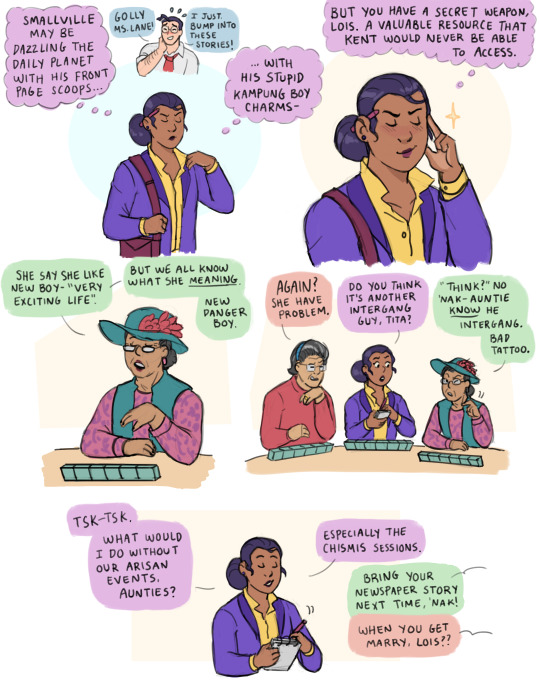
Lois Liando and her trusted asian auntie community. An arisan is a type of money get together (historically a Chinese Indonesian tradition) commonly associated with women. I like to think in Metropolis the tradition expands to include all sorts of Southeast Asian women.
#superman#lois lane#clark kent#dc comics#jl remix#my art#chismis is tagalog for gossip (and yes it has crossover with spanish! cuz colonization in the Philippines and all that)#i think this lends well to classic Lois being a champion for women-listening to them where men would dismiss them
912 notes
·
View notes
Text
Round 3 - Reptilia - Psittaciformes




(Sources - 1, 2, 3, 4)
Our next order of birds are the Psittaciformes, commonly called “psittacines” or “parrots”. Psittaciformes contain the families Cacatuidae (“cockatoos”), Psittacidae (“holotropical parrots”), Psittrichasiidae (“black parrots” and “vasa parrots”), Psittaculidae (“Old World parrots”), and Strigopidae (“New Zealand parrots”).
Parrots are some of the most well known and recognized tropical birds. They have large, strong, sharply downcurved beaks, an upright stance, and clawed, zygodactyl feet (two toes facing forward and two back). They are the only animals that display true tripedalism, using their beak as an extra limb to generate propulsive forces equal to or greater than those generated by the limbs of primates when climbing vertical surfaces. They travel with cyclical tripedal gaits when climbing. Along with corvids, they are considered the most intelligent birds, and are able to use tools, solve puzzles, and mimic human speech; some have been shown to even associate meaning to human words. Most parrots feed on plant material like seeds, nuts, fruit, and buds. Some species eat small animals, eggs, and/or carrion, and lories and lorikeets are specialized for feeding on nectar and fruit juice. Parrots are found on all tropical and subtropical continents and regions including Australia and Oceania, South Asia, Southeast Asia, Central America, South America, and Africa, with the greatest diversity coming from Australasia and South America.
Most parrots are social animals which live in large flocks, and hold no territories other than their nesting sites. All are monogamous, and the pair bonds of the parrots and cockatoos are strong, with a pair remaining close during the nonbreeding season even if they join larger flocks. Almost all parrots nest in cavities such as tree hollows or termite mounds. In most cases, both parents excavate the nest, though in many, only the female incubates the eggs while the male brings her food and guards the nest. Their young are altricial, hatched naked and helpless.
A single 15 mm (0.6 in) fragment from a large lower bill (UCMP 143274), found in deposits from the Lance Creek Formation had been thought to be the oldest parrot fossil, having originated from the Late Cretaceous period. However, this fossil is more likely to have come from a parrot-like caenagnathid oviraptorosaur. It is still generally assumed that the Psittaciformes were present during the K-Pg extinction, 66 million years ago, with modern parrots evolving in the Eocene, around 50 million years ago.
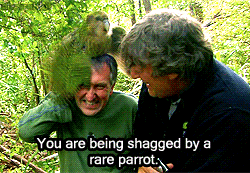
Propaganda under the cut:
A large macaw can have a bite force of 35 kg/cm2 (500 lb/sq in), close to that of a large dog.
Most species are capable of using their feet to manipulate food and other objects with a high degree of dexterity, in a similar manner to a human using their hands. A study conducted with Australian parrots has demonstrated that they exhibit "handedness", a distinct preference with regards to the foot they use to pick up food, with adult parrots being almost exclusively "left-footed" or "right-footed", and with the prevalence of each preference within the population varying by species.
Parrots eat a lot of seeds, and in many cases where they are seen consuming fruit, they are actually just eating the fruit to get at the seed. As seeds often have poisons that protect them, parrots will carefully remove seed coats and other chemically defended fruit parts prior to ingestion. Many species in the Americas, Africa, and Papua New Guinea also consume clay, which releases minerals and absorbs toxic compounds from the gut.
The large, nocturnal, flightless Kākāpō (Strigops habroptilus) (see gif above) is the heaviest parrot, weighing around 4.0 kg (8.8 lb). They are world’s only living flightless parrots, having evolved in New Zealand where they did not have to worry about land predators. Today, the Kākāpō is critically endangered, due to the introduction of mammalian predators like domestic cats, rats, domestic ferrets, and stoats. The current total known population of living individuals is 244, with all known individuals being named and tagged.
The Kea (Nestor notabilis) (image 4), also from New Zealand, is the only alpine parrot, living in the forested and alpine regions of the South Island. Kea are known for their intelligence and curiosity, both vital to their survival in a harsh mountain environment. Kea can solve logical puzzles, such as pushing and pulling things in a certain order to get to food, and will work together to achieve objectives. They have been filmed preparing and using tools. Their natural curiosity and urge to explore and investigate makes this bird both a pest for residents and an attraction for tourists, and they are known to play with (and damage) backpacks, boots, skis, snowboards, and cars. They are known to “steal” unguarded items of clothing, car keys, passports, and rubber parts of cars. Unfortunately, this naturally curious and trusting behavior has led to the endangered bird being illegally killed by poachers in some instances.
Some parrots are active predators of other animals. Golden-winged Parakeets (Brotogeris chrysoptera) prey on aquatic snails. The bulk of the Yellow-tailed Black Cockatoo’s (Zanda funerea) diet consists of grubs. While the Kea’s main source of protein is carrion, it also uncommonly preys on Domestic Sheep (Ovis aries), as well as other birds (including shearwater chicks), and small mammals (including rabbits and mice). Another New Zealand parrot, the Antipodes Parakeet (Cyanoramphus unicolor) is known to prey on adult Grey-backed Storm Petrels (Garrodia nereis) by entering their burrows while they incubate their eggs.
Lories, lorikeets (tribe Loriini), Hanging Parrots (genus Loriculus), and Swift Parrots (Lathamus discolor) are primarily nectar and pollen eaters, having adaptations specifically for this diet, including tongues with brush-like tips.
The Carolina Parakeet (Conuropsis carolinensis) is an extinct species of conure that was once native to the Eastern, Midwest, and Plains states of the United States. It was the only indigenous parrot within its range, and one of only three parrot species native to the United States (the only remaining is the Green Parakeet [Psittacara holochlorus] in some parts of Texas, while the Thick-billed Parrot [Rhynchopsitta pachyrhyncha] has since been extirpated from the US). Carolina Parakeets were hunted, both for the decorative use of their colorful feathers in women's hats, and for reduction of crop predation. Deforestation in the 18th and 19th centuries also likely played a significant role. They were also captured for the pet trade and competed for nest sites with the introduced European Honeybee (Apis mellifera). The last confirmed sighting in the wild of a Carolina Parakeet was in 1910. The last known specimen, a male named Incas, died at the age of 33 at the Cincinnati Zoo in 1918, and the species was declared extinct in 1939.
The endangered El Oro Parakeet (Pyrrhura orcesi) is one of the few parrot species known to breed cooperatively. One breeding pair may be accompanied by up to six helpers.
The Golden Parakeet (Guaruba guarouba) (image 3) is the only other parrot known to breed cooperatively, and they may also be polygamous breeders, with multiple females contributing to a clutch.
The Monk Parakeet (Myiopsitta monachus) is one of the very few parrots known to build a nest, and even among them it is unique. Monk Parakeets breed colonially, building a single huge nest, with separate entrances for each pair. These colonies can become quite large, with pairs occupying separate "apartments" in composite nests that can reach the size of a small car. These “apartments” may attract other tenants who will nest alongside the colony, such as pigeons, sparrows, American Kestrels (Falco sparverius), Yellow-billed Teals (Anas flavirostris), and mammals like squirrels.
The Burrowing Parrot (Cyanoliseus patagonus) excavates burrows that can be as much as 3 m deep into a cliff-face, connecting with other tunnels to create a labyrinth, ending in a nesting chamber. They nest in large colonies, some of the largest of any parrots, up to 70,000 strong, creating “cities” in cliff faces during the breeding season.
Parrots do not have vocal cords, so sound is accomplished by expelling air across the mouth of the trachea in the organ called the syrinx. Different sounds are produced by changing the depth and shape of the trachea.
A study by scientist Irene Pepperberg suggested a high learning ability in a Grey Parrot (Psittacus erithacus) named Alex. Alex was trained to use words to identify objects, describe them, count them, and even answer complex questions such as "How many red squares?" with over 80% accuracy. N'kisi, another Grey Parrot, has been shown to have a vocabulary of around a thousand words, and has displayed an ability to invent and use words in context in correct tenses.
As parrots are highly intelligent and social, an absence of stimuli from members of their own kind can delay the development of young birds. This was demonstrated by a group of Vasa Parrots (genus Coracopsis) kept in tiny cages with Domestic Chickens (Gallus gallus domesticus) from the age of three months; at nine months, these birds still behaved in the same way as three-month-olds, but had adopted some chicken behaviour. Parrots kept as pets or in detrimental environments can, if deprived of stimuli, develop stereotyped and harmful behaviours like self-mutilating. Keepers working with parrots often have dedicated environmental enrichment plans to keep parrots stimulated.
One-third of all parrot species are threatened by extinction, with a higher aggregate extinction risk than any other comparable bird group. Parrots are subjected to more exploitation than any other group of wild birds, and their wild populations have been diminished by trapping both adults and chicks for the pet trade. Half of all parrots live in captivity, with the vast majority of these living as pets in people's homes. Despite many breeders existing, parrots are not domesticated, and very few make good pets as they have complex social, dietary, and enrichment needs, they have strong bites and need to chew, and are naturally very loud. They are also long-term commitments as, depending on species, they can live from 15 to 80+ years, all while requiring the same levels of attention, care, and intellectual stimulation akin to that required by a three-year-old child to survive. Parrot rescue groups estimate that most parrots are surrendered and rehomed through at least five homes before reaching their permanent destinations, or before dying prematurely from unintentional or intentional neglect and abuse. If considering a pet parrot, make sure you have the time, money, and emotional energy to devote to these wild animals, know what you’re getting into, and make sure you adopt from a rescue so as not to fuel this unethical pet trade.
#I say that last point as someone with a pet conure#I love her but if I ever get another bird it’s going to be one that’s actually domesticated#animal polls#round 3#reptilia#Psittaciformes
144 notes
·
View notes
Note
Hello!! Firstly, I love your blog, thank you so much for providing such useful and interesting information! Secondly, how was pirate culture in the Qing dynasty? Especially in regards to their clothes. I'd like to make an Earth Kingdom pirate oc, so I've been taking some inspiration from Jiang from the comics and Ching Shih, a famous pirate, but I'd love to see any information you could provide about this topic! Thank you!
What a neat question! The pirate culture during the Qing Dynasty was really interesting. Since I know I have a lot of historical fashion fans follow this blog, I'll show you the inspiration board I created first and then try to connect it to the Avatar world. If you're interested in the history of Qing era pirates or the greater context behind my clothing recommendations, you can click on the "Keep Reading" line.
So what might the pirates of the Qing Dynasty have worn?
Since Qing Dynasty pirates spent most of their time in the South China Sea and docked along the China-Vietnam borderlands--- both the Qing Dynasty and the Tây Sơn Dynasty had employed these pirates at different points in time--- they were likely a mix of Chinese and Vietnamese culturally, if not ethnically. Their clothing would reflect this, as well as incorporating fabrics and cuts that would be suitable for a tropical climate. In general, their wardrobe would be very Southeast Asian in style.
Since you seem to be designing a female OC, I figured I'd make a collage of clothing and accessories that a Qing Dynasty lady pirate might have.
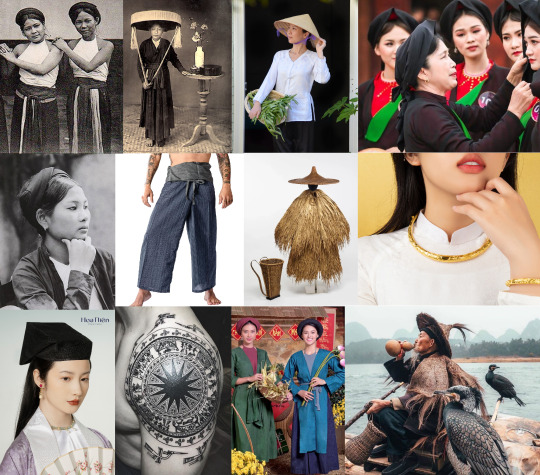
Headwear

Khăn lươn (Vietnamese Women's Headwrap) - Used to keep hair neat and out of the way. It's like a halfway point between a turban and a hairband.
Khăn mỏ quạ (Vietnamese Women's Headscarf) - A bandana that Vietnamese women would wear over their Khăn lươn to shield their hair from the sun. It literally means "Crow's Beak Scarf", because the bandana forms a triangle shape at the front.
Mũ chữ Đinh (Vietnamese Military Officer's Hat) - Many Qing Dynasty pirates would offer their services to the Tây Sơn Dynasty (Vietnamese) navy. I can imagine some pirates wearing these hats as a spoil of war.
Nón lá (Asian Conical Hat) - A traditional hat that is commonly worn in Asia by any profession that labors outside. It's probably the hat most associated with East and Southeast Asia.
Đinh Tự (Vietnamese Women's Hat) - A giant, wide-brimmed hat made from dried palm leaves--- it's basically an Asian conical hat on steroids. Whereas the nón lá is relatively gender-neutral, the dinh tự is considered a feminine hat.
Tops

Yếm / Dudou (Vietnamese/Chinese Halter Top) - Fun Fact: Its original purpose was to keep the belly warm, as the stomach is the sea of chi!
Áo gấm (Vietnamese Tunic) - A thin overcoat worn over the yếm. It's often fastened with a sash.
Áo bà ba (Vietnamese Folk Shirt) - A lightweight shirt with slits on the side.
Suoyi (Chinese Folk Raincoat) - A cloak made out of local materials such as palm leaves and grass. It was also worn by laborers in Vietnam, Japan, and Korea.
Bottoms

Kangkeng Le (Thai Fisherman Pants) - They're from Thailand, but I've seen them worn in other parts of Southeast Asia.
Váy (Vietnamese Skirt)
Miscellaneous Speculation
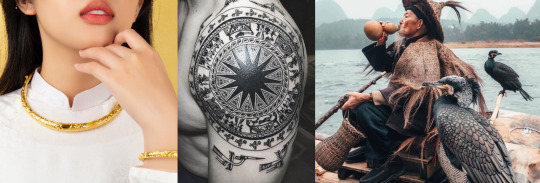
Kiềng (Vietnamese Gold Necklace) - Traditionally, gold or silver Vietnamese/Chinese necklaces were solid rings of metal, rather than being composed of small chain links like European necklaces. I imagine a powerful Asian pirate queen would wear at least three kiềng necklaces.
Tattoos - Since Confucian cultures traditionally considered body modification (including cutting your own hair) to be a sign of rebellion and criminality, tattoos would be the perfect status symbol for an Asian pirate! For a uniquely Vietnamese look, you could try incorporating ancient Vietnamese (Dong Son style) patterns to your design. Alternatively, they could have "protection charm" tattoos on their body, to ensure that the spirits watch over them while at sea or during battle.
Cormorants (Fishing Birds) - Historically, the fishermen of China and Vietnam have trained these species of bird to catch fish for them. I think it would be really cool if your pirate OC had some bird companions.
Weapons
Going to lean into the Vietnamese influence for the weapons as well. Most Vietnamese weapons were heavily inspired by Chinese weapons, but with uniquely Vietnamese touches. Generally, these weapons tended to have more tapered blades, metal engravings with floral patterns, and rattan-corded grips with smaller guards compared to their Chinese counterparts.
Dadao/Trường đao (Chinese/Vietnamese Machetes)

Jian/Kiem (Chinese/Vietnamese Doubled-Edged Swords)

Changdao/Guőm truòng (Chinese/Vietnamese Two-Handed Swords) - Fun fact: These swords were really popular with Chinese and Japanese pirates during the Ming Dynasty, as well.
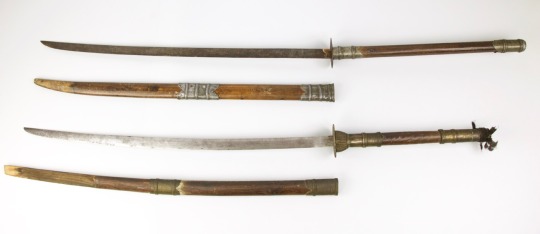
Niuweidao - I don't think there's a Vietnamese version of Oxtail Sabers. Anyways, I've discussed Zuko's trademark swords at length elsewhere. They're civilian weapons that look very pirate-y to me.

Who would the Earth Kingdom pirates be? How would they make a living?

It has been shown that their is a Vietnam analog in the EK, as I've posted about before. The Swampbenders have some Vietnamese inspiration, as well. So the main base operations for EK pirates might have been that EK village that Zuko and Iroh begged in. Maybe the jerk that Zuko stole the swords from was a pirate.
Considering that Froggy Swamp denizens and other Water Tribers would probably be marginalized by EK society, I think their would be good reason for them to become pirates. Especially since waterbending would obviously be a very useful skill to have at sea. Also, since the Northern Water Tribe is shown to be a bit sexist, I could see the surprisingly not-as-sexist world of EK piracy being especially appealing to the ladies of the NWT. As far as EK natives go, farmers and fishermen who've been displaced by the Fire Nation would probably also turn to piracy. Similarly, jaded or corrupt Earth Kingdom and Fire Nation naval officers might switch to piracy, as well. What drives a person to piracy would definitely inform their clothing choices and weaponry.
Like the real-life pirates of the Qing Dynasty, Earth Kingdom pirates likely have no real national loyalties. If you paid them enough, they'd be willing to fight for either the Fire Nation or the Earth Kingdom. You also have to pay them off to cross their territory unscathed. Pirates raid merchant and military ships alike. For refugees who could afford it, they likely paid pirates to smuggle them into Ba Sing Se. Pirates probably also smuggled goods between nations, as well as drugs.
I also think Earth Kingdom pirates would worship water-related spirits, like Yue (+ the Ocean Spirit) or the Painted Lady. Perhaps they'd lay out offerings to spirit alters they'd have onboard or even "feed" the offerings to the seas themselves.
The Greater Context of Chinese Qing Dynasty Piracy
Who were the pirates of the Qing Dynasty?
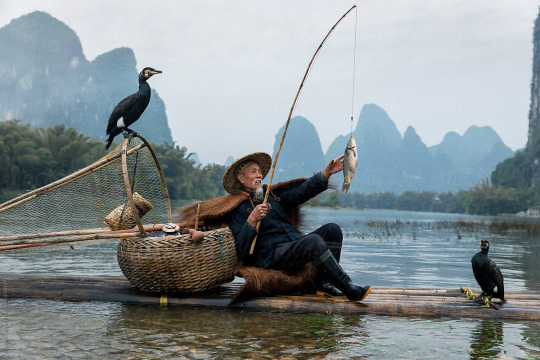
The pirates of Qing Dynasty were predominantly made up of former farmers and fishermen. During this period, population growth in China lead to land shortages and many farmers lost their land either from being unable to keep up with rising taxes or outright theft from corrupt officials. Fishermen turned to piracy when fishing could no longer guarantee their survival, especially with European pirates and colonial ships invading their waters. In general, extreme poverty drove people to piracy.
Also, Chinese pirates were surprisingly more accepting of female leadership than men from more "respectable" parts of society. This is due to the fishermen roots of many pirates. Traditionally, when a fisherman died, his wife was expected to take over his boat and crew. Also, the two most prominent patron Chinese gods of seafarers are goddesses, Guanyin and Mazu.
What did these pirates do?

Qing Dynasty pirates were a unique fusion of bandit, mercenary, and drug smuggler. Obviously, if you planned on sailing through pirate-infested waters, you had better pay off the pirates to be left unscathed. Otherwise, your ship was getting plundered.
Qing pirates also offered up their talent for violence to the highest bidder during times of war. In the 18th century, Imperial Vietnam would frequently hire and train up Southern Chinese pirates to assist their fleets during naval battles. Those who earned merit during these conflicts would even be granted official military titles. In 1857, the Chinese government would even employ these same South Sea pirates to take down the Portuguese pirates terrorizing their waters.
Finally, as Qing Dynasty piracy reached its epoch at the same time as the First Opium War, Chinese pirates participated in a lot of drug smuggling. As pirates have no loyalty, they had no issue serving as middle-men in the profitable European drug trade.
Where were these pirates found?
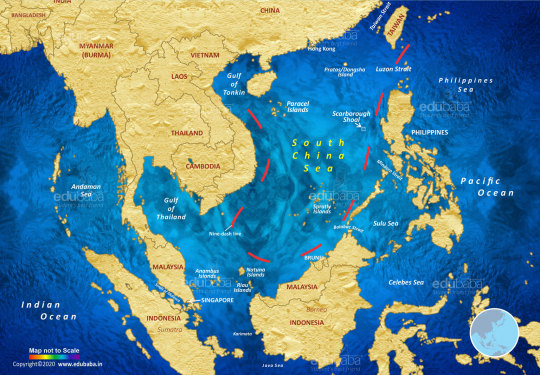
The South China Sea was the stomping ground for Qing-era pirates, particularly the Gulf of Tonkin. In terms of ports and towns, they tended to spend a lot of time in the border areas where China met Vietnam. Remember that these pirates offered their services to both Imperial Vietnam and Imperial China, so they didn't exactly have national loyalties.
#atla#avatar the last airbender#avatar#atlaculture#earth kingdom#vietnam#cultural fashion#cultural weapons#I went a bit overboard with this post#no pun intended#I'm just really into the idea of incorporating more Southeast Asian cultures into the ATLAverse#I also just think outlaws are kind of neat#replies
261 notes
·
View notes
Text




"Movie Theater McDonald's" - Raleigh, NC (1984)
"To commemorate McDonald's thirtieth anniversary, regional managers were asked to select one property in their respective areas that would be shaped into a one-of-a-kind design. Bruce Wunner, the chain's southeast regional manager, chose a newly acquired site in Raleigh: a circa 1920 building last used as a movie theater (first opened as the Varsity Theatre in 1941) and located on busy Hillsborough Street. The fact that the interior of the building was laid out like a theater, and the fact that McDonald's was founded in 1955, gave Perry & Plummer Design Associates (Wilmington and Raleigh, North Carolina) the inspiration for the design theme. The stage was set for a fifties diner articulated within the shell of the old theater."
Architecture by Fred Tolson Associates, interior design by Perry & Plummer
Scanned from the Dec. 1986 issue of Contract Interiors, and Restaurant Design: Ninety-Five Spaces That Work (1987)
1K notes
·
View notes